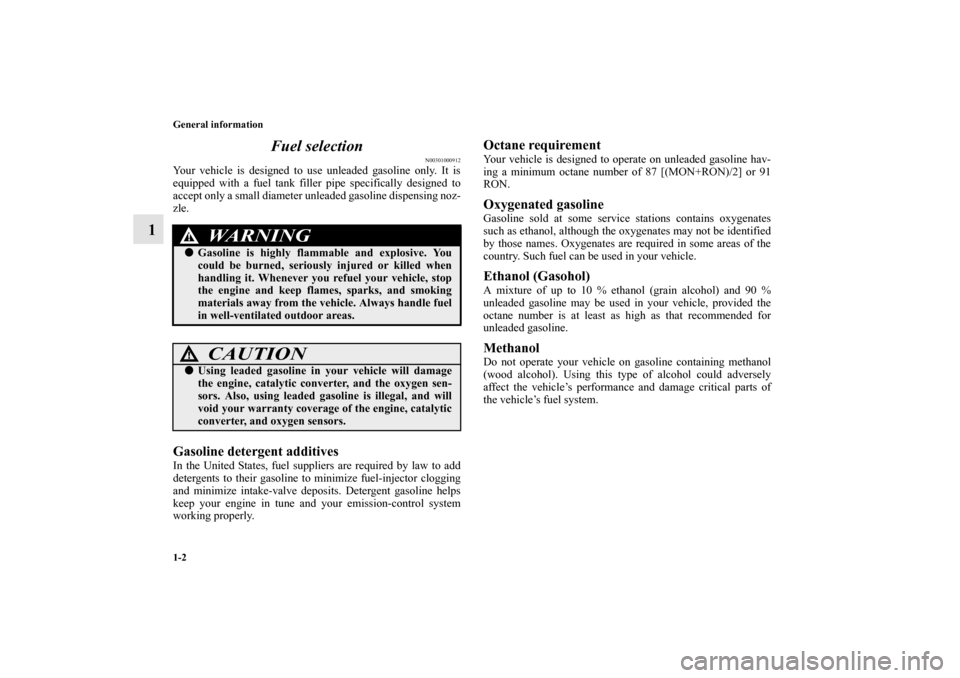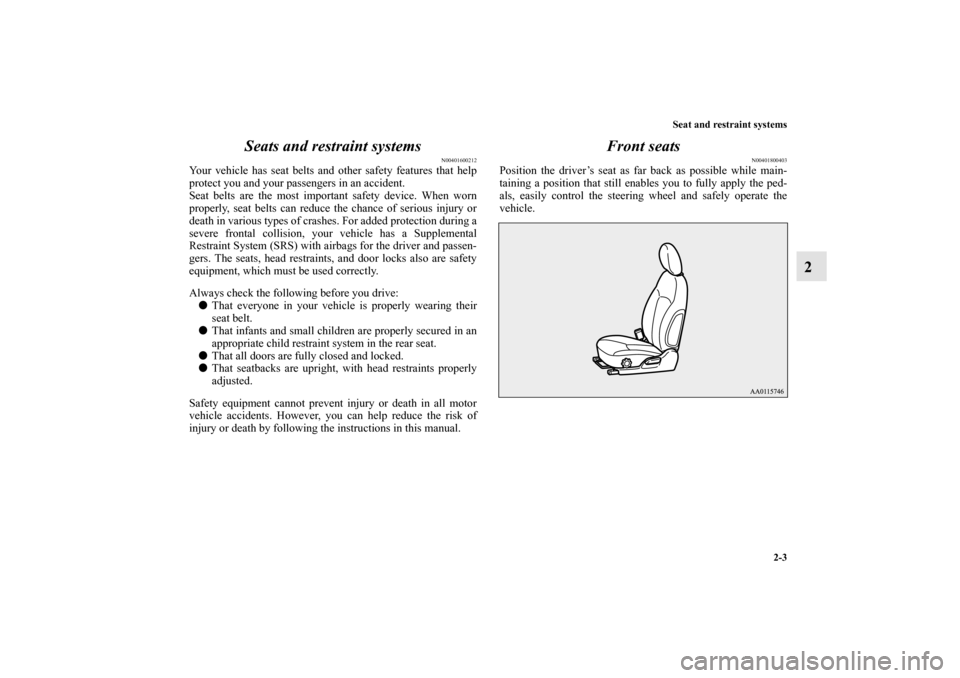Page 3 of 460
Overview
Audio (if so equipped) P.5-30
Mitsubishi Multi Entertainment
System (if so equipped)
Refer to the separate “Mitsubishi
Multi Entertainment System
owner’s manual”
Clock (if so equipped) P.5-39Center vents P.5-2 Supplemental restraint system
(SRS)-airbag (for front passenger)
P.2-35, 2-45
Side vents P.5-2
Engine hood release lever
P. 7 - 5
Fuel tank filler door release
lever P.1-4Cup holder (for the
front seat) P.3-165
Gearshift lever (if so equipped)
P.3-59
Selector lever (if so equipped)
P.3-61
Cup holder (for the rear seat)
P. 3 - 1 6 5Parking brake lever P.3-48Key slot (if so
equipped) P.3-2912 V power outlets
P.3-161Compartment
P. 3 - 1 6 5
Electric rear window defogger
switch P.3-125 Automatic air conditioning (if so
equipped) P.5-17 Heater (if so equipped) P.5-6
Manual air conditioning (if so
equipped) P.5-11
Electric rear window defogger
switch P.3-125
BK0162600US.book 2 ページ 2013年3月22日 金曜日 午後2時41分
Page 4 of 460
Overview
Interior
N00100301245
Power window lock switch P.3-44
Power window switch P.3-43
Seat belts P.2-14
Supplemental restraint system
(SRS)-curtain airbags P.2-53
Manual window control
(if so equipped) P.3-43
Cargo room light
P.3-164, 7-45
Rear shelf panel (if so equipped)
P. 3 - 1 6 7
Rear seats P.2-8Jack (if so equipped) P.6-7Supplemental restraint system
(SRS)-side airbag (for front
seat) P.2-52Front seats P.2-2Heated seats (if so
equipped) P.2-7 USB input terminal
(if so equipped)
P. 3 - 1 5 3Head restraints
P. 2 - 1 1 Inside rearview mirror P.3-50 Dome light P.3-162, 7-45 Microphone P.3-129 Bottle holders P.3-166
Sun visors P.3-160
Vanity mirror P.3-160
Card holder P.3-160 Power door lock switch
(if so equipped) P.3-38
BK0162600US.book 3 ページ 2013年3月22日 金曜日 午後2時41分
Page 13 of 460

Quick index5
If this problem occurs...
N00200900870
Problem
Do this
Ref. Page
Unable to turn the key.
(except for vehicles equipped
with the F.A.S.T.-key) From “ACC” to “OFF”
Vehicles with continuously variable transmission (CVT):
Check the position of the selector lever.
The key cannot be removed unless the selector lever is set to the “P” (PARK) position. P. 3-55
The engine does not start when
the engine switch is pressed.
(for vehicles equipped with the
F. A . S . T. - k e y ) Make sure the F.A.S.T.-key is in the vehicle.
Vehicles with manual transaxle:
Press and hold the clutch pedal all the way down, and then press the engine switch while
depressing the brake pedal.
Vehicles with continuously variable transmission (CVT):
Make sure the selector lever is in the “P” (PARK) position, and then press the engine
switch while depressing the brake pedal.
P. 3-24
The F.A.S.T.-key does not
operate.
(for vehicles equipped with the
F. A . S . T. - k e y ) Use the emergency key to lock and unlock the door.
Insert the F.A.S.T.-key into the key slot of the floor console, and then start the engine or
change the operation mode.
P. 3-26, 3-27
BK0162600US.book 5
\bM\bo\b+ 2013年3月22日 金曜日 午後2時41\f
Page 18 of 460

1-2 General information
1Fuel selection
N00301000912
Your vehicle is designed to use unleaded gasoline only. It is
equipped with a fuel tank filler pipe specifically designed to
accept only a small diameter unleaded gasoline dispensing noz-
zle.Gasoline detergent additivesIn the United States, fuel suppliers are required by law to add
detergents to their gasoline to minimize fuel-injector clogging
and minimize intake-valve deposits. Detergent gasoline helps
keep your engine in tune and your emission-control system
working properly.
Octane requirementYour vehicle is designed to operate on unleaded gasoline hav-
ing a minimum octane number of 87 [(MON+RON)/2] or 91
RON.Oxygenated gasolineGasoline sold at some service stations contains oxygenates
such as ethanol, although the oxygenates may not be identified
by those names. Oxygenates are required in some areas of the
country. Such fuel can be used in your vehicle.Ethanol (Gasohol)A mixture of up to 10 % ethanol (grain alcohol) and 90 %
unleaded gasoline may be used in your vehicle, provided the
octane number is at least as high as that recommended for
unleaded gasoline.MethanolDo not operate your vehicle on gasoline containing methanol
(wood alcohol). Using this type of alcohol could adversely
affect the vehicle’s performance and damage critical parts of
the vehicle’s fuel system.
WA R N I N G
!�Gasoline is highly flammable and explosive. You
could be burned, seriously injured or killed when
handling it. Whenever you refuel your vehicle, stop
the engine and keep flames, sparks, and smoking
materials away from the vehicle. Always handle fuel
in well-ventilated outdoor areas.
CAUTION
!�Using leaded gasoline in your vehicle will damage
the engine, catalytic converter, and the oxygen sen-
sors. Also, using leaded gasoline is illegal, and will
void your warranty coverage of the engine, catalytic
converter, and oxygen sensors.
BK0162600US.book 2 ページ 2013年3月22日 金曜日 午後2時41分
Page 20 of 460

1-4 General information
1Filling the fuel tank
N00301100913
WA R N I N G
!�When handling fuel, comply with the safety regula-
tions displayed by garages and filling stations.�Gasoline is highly flammable and explosive. You
could be burned, seriously injured or killed when
handling it. When refueling your vehicle, always
turn the engine off and keep away from flames,
sparks, and smoking materials. Always handle fuel
in well-ventilated outdoor areas.�Before removing the fuel tank filler cap, be sure to
get rid of your body’s static electricity by touching a
metal part of the car or fuel pump. Any static elec-
tricity on your body could create a spark that ignites
fuel vapor.�Perform the whole refueling process (opening the
fuel tank filler door, removing the fuel tank filler
cap, etc.) by yourself; do not let any other person
near the fuel tank filler. If you allowed a person to
help you and that person was carrying static elec-
tricity, fuel vapor could be ignited.�Do not move away from the fuel tank filler until
refueling is finished. If you moved away and did
something else (for example, sitting on a seat) part-
way through the refueling process, you could pick
up a fresh charge of static electricity.�Be careful not to inhale fuel vapor. Fuel contains
toxic substances.
�Keep the doors and windows closed while refueling
the vehicle. If they were open, fuel vapor could get
into the cabin.
WA R N I N G
!
BK0162600US.book 4 ページ 2013年3月22日 金曜日 午後2時41分
Page 21 of 460
General information
1-5
1
Fuel tank capacity9.2 gal (35 L)Refueling1. Before filling with fuel, stop the engine.
2. The fuel tank filler is located on the rear driver side of
your vehicle.
The fuel tank filler door can be opened from inside the
vehicle with the fuel tank filler door release lever located
at the left side of the driver’s seat.3. Open the fuel tank filler pipe by slowly turning the fuel
tank filler cap counterclockwise.
1- Remove
2- Close
BK0162600US.book 5 ページ 2013年3月22日 金曜日 午後2時41分
Page 22 of 460

1-6 General information
1
4. While filling with fuel, hang the fuel tank filler cap cord
on the hook located on the inside surface of the fuel tank
filler door.5. To fill with fuel correctly depends mainly on correct han-
dling of the fuel filler nozzle. Do not tilt the nozzle. Insert
the nozzle in the fuel tank filler port as far as it goes.
6. When the nozzle stops automatically, do not add more
fuel.
7. To close, turn the fuel tank filler cap slowly clockwise
until you hear clicking sounds, then gently push the fuel
tank filler door closed.
WA R N I N G
!�Since the fuel system may be under pressure,
remove the fuel tank filler cap slowly. This relieves
any pressure or vacuum that might have built up in
the fuel tank. If the fuel tank filler cap is venting
vapor or if you hear a hissing sound, wait until the
sound stops before removing the fuel tank filler cap.
Otherwise, fuel may spray out, injuring you or oth-
ers.
CAUTION
!�Your vehicle can only be operated using unleaded
gasoline. Serious engine and catalytic converter
damage will result if leaded gasoline is filled into
these vehicles, and consequently, this must never be
attempted.
CAUTION
!�To avoid fuel spillage and overfilling, do not “top-
off” the fuel tank. Spilled fuel could discolor, stain,
or crack the vehicle’s paintwork. If fuel spills on the
paintwork, wipe it off with a soft cloth.
WA R N I N G
!�Make sure the fuel tank filler cap is securely closed.
If the fuel tank filler cap were loose, fuel could leak,
resulting in a fire.
BK0162600US.book 6 ページ 2013年3月22日 金曜日 午後2時41分
Page 29 of 460

Seat and restraint systems
2-3
2 Seats and restraint systems
N00401600212
Your vehicle has seat belts and other safety features that help
protect you and your passengers in an accident.
Seat belts are the most important safety device. When worn
properly, seat belts can reduce the chance of serious injury or
death in various types of crashes. For added protection during a
severe frontal collision, your vehicle has a Supplemental
Restraint System (SRS) with airbags for the driver and passen-
gers. The seats, head restraints, and door locks also are safety
equipment, which must be used correctly.
Always check the following before you drive:
�That everyone in your vehicle is properly wearing their
seat belt.
�That infants and small children are properly secured in an
appropriate child restraint system in the rear seat.
�That all doors are fully closed and locked.
�That seatbacks are upright, with head restraints properly
adjusted.
Safety equipment cannot prevent injury or death in all motor
vehicle accidents. However, you can help reduce the risk of
injury or death by following the instructions in this manual.
Front seats
N00401800403
Position the driver’s seat as far back as possible while main-
taining a position that still enables you to fully apply the ped-
als, easily control the steering wheel and safely operate the
vehicle.
BK0162600US.book 3 ページ 2013年3月22日 金曜日 午後2時41分